Michigan’s diverse landscapes, from lush forests to sprawling wetlands, provide a welcoming home for several species of wrens. These small, energetic songbirds are known for their lively personalities, bold songs, and ability to thrive in a variety of habitats.
In this guide, we’ll explore seven types of wrens that can be spotted in Michigan, from common backyard visitors to rare, accidental wanderers. Along the way, you’ll learn how to identify each species, where to find them, and what makes them unique.
Common Wrens Found in Michigan
House Wren (Troglodytes aedon)
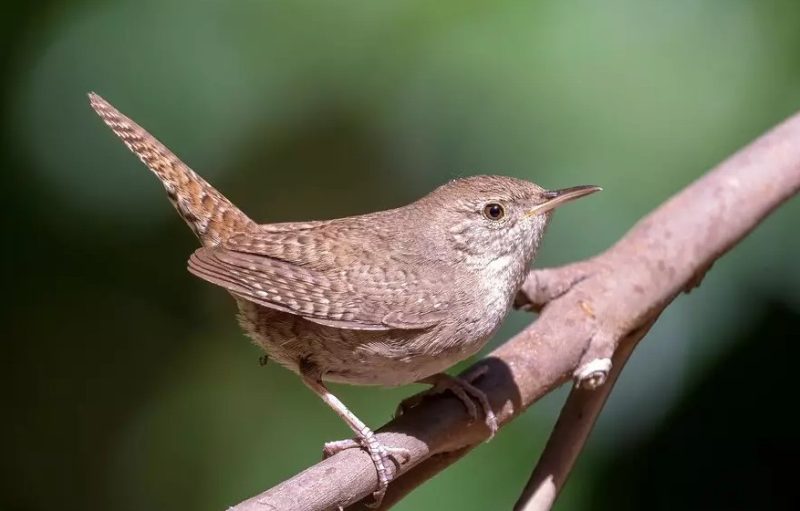
The House Wren is one of the most familiar small songbirds in Michigan during the warmer months. Measuring about 4.3 to 5.1 inches (11–13 cm) in length with a wingspan of 5.9 to 6.7 inches (15–17 cm), it has a plain brown back, lightly barred wings and tail, and a faint pale eyebrow. Its small, slightly curved bill and short, upright tail give it a distinctive silhouette. While unassuming in color, its restless energy and constant movement make it easy to notice once you know where to look.
Behaviorally, House Wrens are highly active and curious, flitting from branch to branch in search of food. They are cavity-nesting birds and will readily use birdhouses or natural tree hollows, often filling them with twigs before lining them with softer materials. Known for their competitive nature, they sometimes remove nesting material or even eggs from nearby cavities to reduce competition. During the breeding season, they display boldness unusual for such a small bird, defending their chosen territory vigorously.
Their song is a bubbling, musical series of trills and rattles, delivered with remarkable volume for such a tiny bird. Males sing frequently to attract mates and defend territories, and both sexes produce a variety of sharp calls when alarmed. In Michigan, House Wrens arrive in late April or early May and remain through late summer, with some staying into September before migrating south to the southern U.S., Mexico, and Central America.
Diet consists mainly of insects and spiders, which they glean from foliage, bark, and even the ground. They frequent gardens, backyards, forest edges, and open woodlands, thriving in areas with scattered trees and shrubs. In Michigan, they are common across the Lower and Upper Peninsulas during the breeding season, making them one of the state’s most widespread wrens.
Carolina Wren (Thryothorus ludovicianus)

The Carolina Wren is larger and more robust than most wrens, measuring about 4.7 to 5.5 inches (12–14 cm) long with a wingspan of 11 inches (28 cm). It is rich reddish-brown above, warm buff below, and features a bold white eyebrow stripe. Its slightly decurved bill is well adapted for probing into bark crevices. The tail is long, often held upright, and the wings are rounded. These features, combined with its confident stance, make it relatively easy to distinguish from other wrens in Michigan.
Unlike the migratory House Wren, the Carolina Wren is a permanent resident in southern Michigan, although harsh winters can reduce their numbers. They are inquisitive and energetic, frequently hopping through dense undergrowth, brush piles, and thickets. They nest in a variety of locations, from tree cavities to hanging planters, and have a tendency to choose unusual spots like mailboxes or garages. Both sexes share in feeding the young, and pairs often remain together year-round.
Its song is one of the loudest among wrens — a clear, ringing “tea-kettle, tea-kettle, tea-kettle” phrase repeated several times. Males sing throughout the year, even in midwinter snow, which makes them more noticeable than other wrens during the cold season. In addition to their primary song, Carolina Wrens use a variety of scolding and chattering calls when disturbed.
They feed mostly on insects, spiders, and occasionally small fruits or seeds, especially in winter when insect prey is scarce. In Michigan, they are found primarily in the southern counties, favoring wooded suburban neighborhoods, forest edges, and shrubby clearings. Their range has been expanding northward in recent decades, aided by milder winters and the availability of backyard feeders.
Winter Wren (Troglodytes hiemalis)
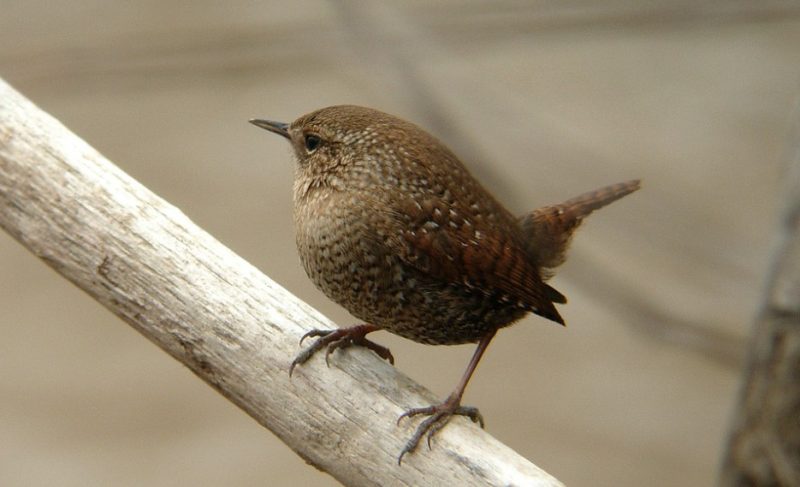
The Winter Wren is one of the smallest wrens, measuring only 3.1 to 4.3 inches (8–11 cm) in length with a wingspan of 4.7 to 6.3 inches (12–16 cm). It has a dark, heavily barred brown body, a very short tail often held upright, and a fine, slightly curved bill. Its compact, round shape and restless movement give it a mouse-like appearance as it hops low through dense undergrowth. In Michigan, it is more often heard than seen due to its shy nature and preference for thick cover.
These wrens breed in Michigan’s northern coniferous and mixed forests, particularly in the Upper Peninsula and northern Lower Peninsula. They prefer damp, mossy areas with fallen logs, roots, and dense ferns, often near streams or wetlands. In winter, most migrate to the southeastern United States, though a few may linger in sheltered southern Michigan habitats. They construct domed nests of moss and leaves in hidden spots, such as among tree roots or in upturned stumps.
The song of the Winter Wren is remarkably long and complex, often lasting up to 10 seconds and consisting of a rapid, cascading series of trills and whistles. Males sing persistently during the breeding season, and their voices can carry surprisingly far through the forest. They also produce sharp “chip” calls when alarmed.
Diet consists primarily of insects, spiders, and other small invertebrates, which they glean from moss, bark, and leaf litter. In Michigan, they are most common during spring and fall migration but remain as breeders in suitable northern habitats. Birdwatchers seeking this elusive species in summer often have better luck listening for its song rather than trying to spot its well-camouflaged form.
Marsh Wren (Cistothorus palustris)
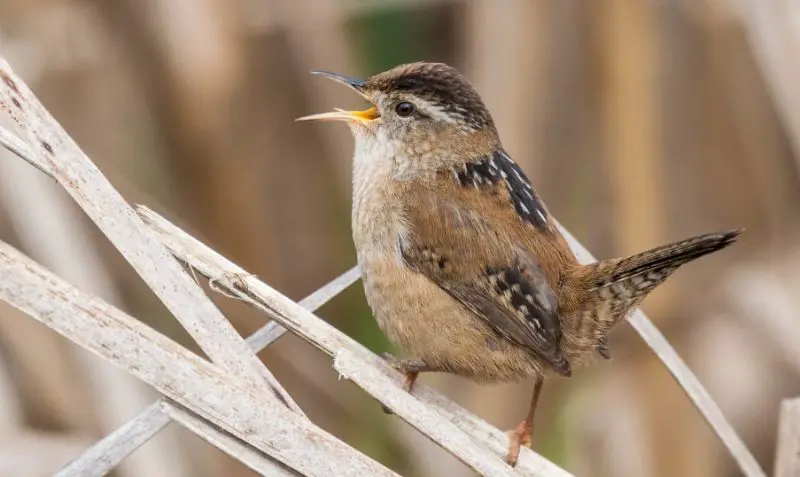
The Marsh Wren is a small but energetic bird measuring about 3.9 to 5.5 inches (10–14 cm) long with a wingspan of 5.9 to 7.1 inches (15–18 cm). It has a brown back with black and white streaks on the upper back, a white eyebrow stripe, and buffy underparts. Its tail is short and often held upright. Compared to the similar Sedge Wren, the Marsh Wren has a bolder face pattern and tends to favor wetter habitats.
True to its name, the Marsh Wren inhabits cattail marshes, wet meadows, and reed beds during the breeding season in Michigan. Males are industrious builders, often constructing multiple dome-shaped nests woven from grasses and cattails, though only one will be used for raising young. They arrive in Michigan in late April or May and depart for the southern United States and Mexico by early fall.
The song is a rapid, chattering series of gurgles, rattles, and buzzes, delivered from an exposed perch atop cattails. Each male has a repertoire of variations, and the sound can be heard echoing across wetlands on spring mornings. Marsh Wrens also produce sharp scolding calls when intruders approach their nesting area.
Diet consists of insects, spiders, and other small invertebrates, which they capture by climbing and probing among vegetation. In Michigan, they are widely distributed in wetlands across both peninsulas, though they are most abundant in large cattail marshes along lakeshores and river floodplains. Their reliance on healthy wetland ecosystems makes them good indicators of marsh habitat quality.
Sedge Wren (Cistothorus stellaris)
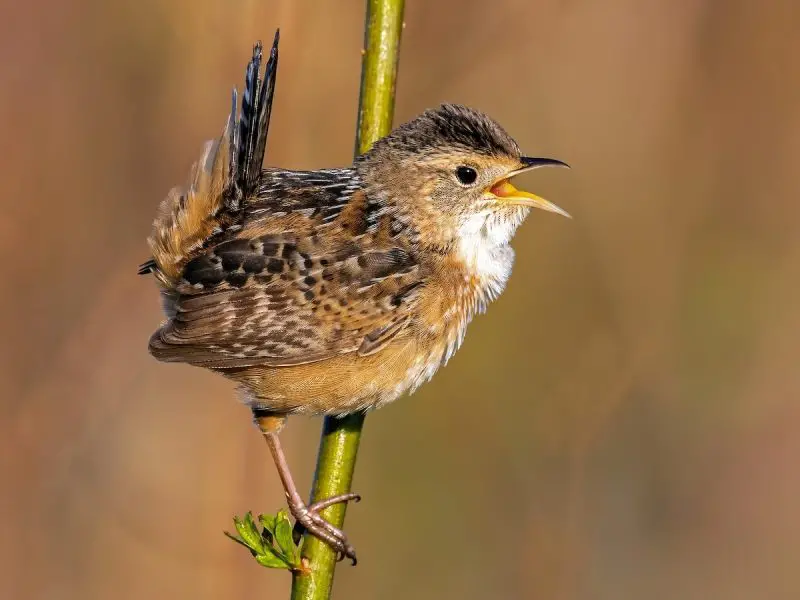
The Sedge Wren is a small, secretive grassland wren measuring about 3.9 to 4.7 inches (10–12 cm) long with a wingspan of 5.7 inches (14.5 cm). Its plumage is brown and heavily streaked above, with a faint white eyebrow stripe, pale underparts, and a short tail. The streaked crown and back help camouflage it among grasses and sedges. Compared to the Marsh Wren, it has a less distinct face pattern and tends to stay in drier habitats.
This species is known for its unpredictable presence in Michigan — it often arrives later than other wrens, sometimes not until June, and its breeding locations can shift from year to year. It favors wet meadows, sedge fields, and lightly flooded grasslands. Sedge Wrens build ball-shaped nests low in grasses, well hidden from view. Because of their late arrival and nomadic tendencies, they are more difficult for birders to find consistently.
The song is a series of dry, insect-like chips and short trills, less musical than that of other wrens but distinctive once learned. Males sing persistently from grass stems during breeding season, though their small size and secretive habits make them tricky to spot. They also use short, harsh calls to signal alarm.
Sedge Wrens feed mainly on insects and spiders, gleaning prey from grass stems and the ground. In Michigan, they breed patchily across both peninsulas, with higher concentrations in areas where suitable grassland habitat is preserved. Because they rely on undisturbed wet meadows and prairies, they are vulnerable to habitat loss from agricultural mowing and development.
Rock Wren (Salpinctes obsoletus)

The Rock Wren is a medium-sized wren, measuring 5.9 to 6.7 inches (15–17 cm) long with a wingspan of about 9.8 inches (25 cm). It is pale grayish-brown above, whitish below with fine dark speckling on the chest, and has a faint white eyebrow stripe. The tail is relatively long and often flicked up and down, and the bill is slightly decurved. Its coloration blends perfectly with rocky landscapes, giving it its name.
In Michigan, the Rock Wren is extremely rare and considered an accidental species, with only a few documented sightings, usually during migration when individuals stray far from their typical range in the western United States. They prefer arid, rocky slopes, canyon walls, and boulder-strewn hillsides, which makes Michigan’s usual habitat unsuitable. The few birds that do appear are often found in gravel pits, rocky shorelines, or man-made structures that mimic their native environment.
The song of the Rock Wren is a varied series of high, clear whistles, trills, and musical phrases, often delivered from an elevated perch. They also produce sharp “tek” notes when alarmed. Males may have large song repertoires and will sing from multiple vantage points in their territory. In Michigan, hearing one is an exceptional occurrence due to their rarity.
Diet consists mainly of insects and spiders, which they capture by hopping along the ground and probing crevices. Outside of their typical range, Rock Wrens are often seen foraging in open, sparsely vegetated areas. In Michigan, these rare appearances are usually brief, with the birds moving on quickly, making them a special treat for dedicated birdwatchers.
Bewick’s Wren (Thryomanes bewickii)
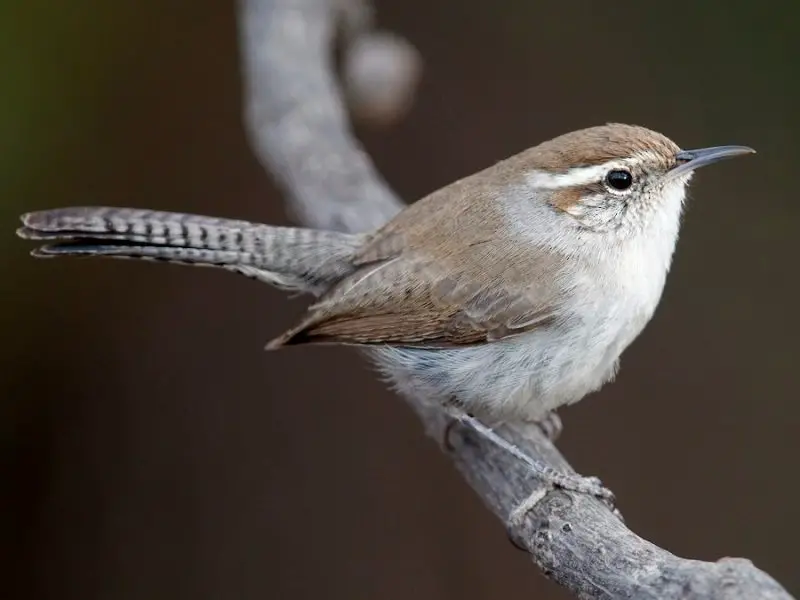
Bewick’s Wren is a slender, medium-sized wren measuring 4.9 to 5.5 inches (12.5–14 cm) in length with a wingspan of about 7 inches (18 cm). It has a long, slightly curved bill, a bold white eyebrow stripe, and a long tail with white corners that it often flicks. The upperparts are warm brown, and the underparts are pale gray. Compared to the Carolina Wren, it is slimmer, with a more distinct tail pattern and less reddish coloration.
This species is a rare accidental visitor to Michigan, with only scattered records. Its normal range is in the southern and western United States, where it inhabits brushy thickets, open woodlands, and scrubby fields. Sightings in Michigan typically occur during migration, when wandering individuals appear far outside their usual territory. Because of its rarity, most observations come from experienced birders carefully scanning mixed flocks in shrubby areas.
Bewick’s Wren has a sweet, musical song made up of clear whistles and short trills, with variations between individuals and regions. Males sing throughout the breeding season, and the song can carry surprisingly far for such a small bird. Its call notes are sharp and metallic, often given when the bird is agitated or alert. In Michigan, its voice is not commonly heard due to its scarcity.
Its diet is dominated by insects, spiders, and occasionally seeds or berries. It forages actively, probing bark crevices, leaf litter, and low shrubs. In its usual range, it readily uses nest boxes, but in Michigan, any sighting is typically a brief encounter rather than a breeding record. For local birdwatchers, spotting a Bewick’s Wren is a noteworthy and memorable event, as it represents one of the rarest wrens in the state.
FAQs About Wrens in Michigan
How many types of wrens are found in Michigan?
Michigan has seven recorded wren species. Five of them — House Wren, Carolina Wren, Winter Wren, Marsh Wren, and Sedge Wren — occur regularly, while two — Rock Wren and Bewick’s Wren — are rare accidental visitors.
Which wren is the most common in Michigan?
The House Wren is the most common and widespread wren species in Michigan. It breeds throughout the state in summer and is often found in backyards, parks, and woodland edges.
Are Carolina Wrens found year-round in Michigan?
Yes, Carolina Wrens are permanent residents in southern Michigan. However, severe winters can reduce their numbers, and they are more concentrated in the southern counties where food and shelter are abundant.
Where can I see Winter Wrens in Michigan?
Winter Wrens are most often found in northern Michigan’s coniferous and mixed forests during summer. They prefer damp, mossy areas near streams or wetlands, especially in the Upper Peninsula.
What habitats do Marsh Wrens prefer?
Marsh Wrens breed in cattail marshes, wet meadows, and reed beds across Michigan. They are particularly abundant in large wetlands along lakeshores and river floodplains.
Why are Sedge Wrens harder to find than Marsh Wrens?
Sedge Wrens arrive later in the breeding season, sometimes not until June, and their breeding locations vary from year to year. They also prefer drier grassy wetlands and sedge meadows, making them less predictable.
Are Rock Wrens common in Michigan?
No, Rock Wrens are very rare in Michigan. They normally live in the western United States and only appear in Michigan as accidental migrants, usually in rocky or gravelly habitats.
How rare is Bewick’s Wren in Michigan?
Bewick’s Wren is one of the rarest wrens in the state, with only a few scattered sightings. It is mainly a species of the southern and western United States and is not a regular breeder in Michigan.
What do wrens eat in Michigan?
All wrens primarily eat insects and spiders. Some species, like Carolina Wrens, also consume seeds, berries, and suet during the winter when insect prey is scarce.
Do wrens migrate out of Michigan in winter?
Most Michigan wrens, such as House Wrens, Winter Wrens, Marsh Wrens, and Sedge Wrens, migrate south for the winter. Carolina Wrens are an exception, staying year-round in the southern parts of the state.






